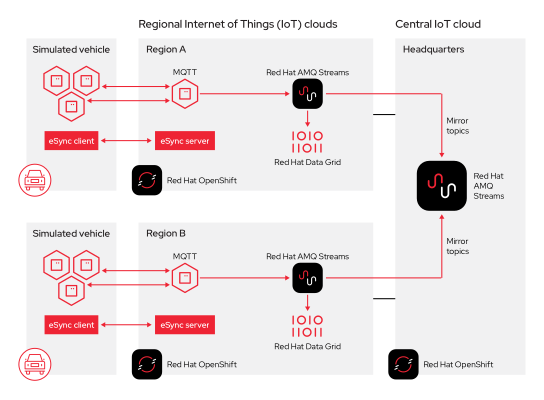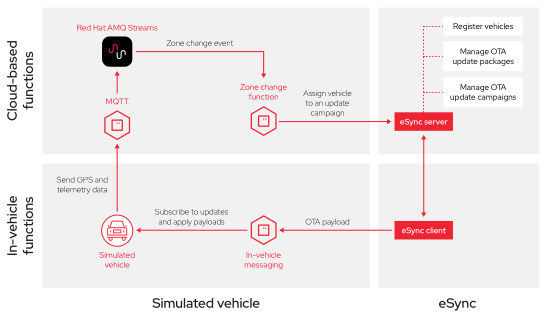Deploy over-the-air infrastructure using open source technologies
Cloud-native technologies power over-the-air updates and data collection for automakers
The automotive industry is undergoing digital transformation and rapid innovation. Automakers are now differentiating themselves with software-defined vehicles that deliver enhanced driver and passenger experiences. Rather than relying upon discrete electronic computing units (ECUs), software-defined vehicles implement core vehicle aspects in software running on standardized, general-purpose hardware. As a result, automakers can select, change, and update key vehicle functions without changing the underlying hardware.
Over-the-air (OTA) updates and data gathering play an essential role in software-defined vehicles. These technologies create a closed communication loop between the cloud-based development and simulation environments where software is built and tested and physical instantiations of released software in working vehicles. With OTA updates, automakers can increase the safety, performance, handling, and capabilities of automobiles after they are sold, and without requiring owners to visit a dealership or service point.
OTA updates can be performed in several ways today, resulting in a fragmented market and varying approaches. Adopting common approaches, based on accepted standards, can help more automakers take advantage of OTA updates to improve automobile quality and capabilities across the industry. Automakers are also interested in adopting open source technologies — like Linux® — to take advantage of the collaboration, innovation, and security open source projects offer.
A consortium of cooperating tier-one integrators, software and hardware vendors, and cloud service providers, the eSync Alliance has published a standard specification for OTA updates and data gathering for vehicles. This specification defines a proven, security-focused data pipeline between edge devices in a vehicle and cloud environments using a software-based, three-tier model. The eSync standard allows companies in the automotive value chain to participate in OTA operations — companies would be able to reach any eSync-compliant module to provide updates and increased value.
The standard also provides guidelines and complies with the regulatory cybersecurity and software update management system (SUMS) requirements defined by the United Nations Economic Commission for Europe (UNECE) World Forum for Harmonization of Vehicle Regulations (WP.29).
Using eSync application programming interfaces (APIs), Red Hat has created a proof of concept deployment of eSync running on a Red Hat® foundation.
Standardization connects industries and technologies
Agreeing on a common set of standards can bring the automotive industry together.
The eSync Alliance is working to create a single standard that spans cloud-to-car-to-device connectivity, vehicle gateways, data management, and middleware with end-to-end cybersecurity. This will allow organizations within the automotive industry to reach any eSync-compliant module across varying in-vehicle networks.
Read more about Red Hat and the eSync Alliance’s approach to OTA standardization.
Run eSync across clouds with Red Hat OpenShift
Automakers and suppliers want the flexibility to run their programs and services in their choice of cloud environments. Red Hat OpenShift® provides a consistent, standardized platform for running eSync servers across hybrid and multicloud environments. It is certified for use in all major public clouds and is also available as managed cloud services on Amazon Web Services (AWS), Google Cloud, IBM Cloud, and Microsoft Azure. As a result, you can deploy eSync with Red Hat OpenShift across any cloud, or multiple clouds, with consistency.
Deployment, management, scaling, and overall operations remain the same regardless of which cloud you use. Red Hat OpenShift—as well as other open source products within the Red Hat portfolio—support the cybersecurity needs defined in the eSync and applicable regulatory standards.
Example cloud-native vehicle update and communication environment
Combining Red Hat’s open source portfolio with eSync standards and APIs lets you create a cloud-native environment to support vehicle updates and communication. Other key components running within Red Hat OpenShift include:
- Red Hat Application Services, including Red Hat AMQ, Red Hat Data Grid, and Red Hat Fuse, provide comprehensive messaging frameworks, integration solutions, runtimes, and programming languages for creating a unified environment for application development, delivery, integration, and automation.
- Red Hat Quay is an enterprise container image registry that provides storage and allows you to build, distribute, and deploy containers.
- Red Hat Advanced Cluster Management for Kubernetes extends the value of Red Hat OpenShift with a single console for deploying applications, managing clusters, and enforcing policies across clusters at scale.
Red Hat has published an opinionated design for simulating connected vehicles traveling through update zones. This architecture can serve as a foundation for automotive hybrid cloud and eSync deployments. Each time a simulated vehicle enters a new update zone, it receives configuration and service information via an OTA update, which can be managed via eSync.
Red Hat uses containers and hybrid cloud technologies to create a cloud-native foundation for OTA updates.
Our approach to OTA updates will accelerate automotive industry innovations like:
- Shifting to zonal controllers.
- Introducing Linux and open source software into vehicles.
- Increasing open source standardization.
- Developing container-based approaches.
The design includes simulated vehicles, regional cloud environments, and a central cloud environment. An eSync client runs in each simulated vehicle, and eSync servers run in containers in central or regional clouds to manage in-vehicle data collection and configuration updates. Each eSync server can connect to multiple vehicles via their eSync clients. Simulated vehicles send telemetry data to the regional clouds via MQTT (Message Queuing Telemetry Transport) and Red Hat AMQ Streams, Red Hat’s enterprise Kafka distribution. Red Hat AMQ Streams then sends the data to Red Hat Data Grid for regional caching and storage of configuration data. Red Hat AMQ Streams also mirrors the data to the central cloud for aggregation and further analysis. Aggregated data, maps, and real-time vehicle information are shown via a dashboard running on Red Hat OpenShift.
Figure 2 shows the communication flow between the Red Hat OpenShift cloud environments, eSync client and server, and vehicle functions when a simulated vehicle enters an update zone and receives an update.
Learn more
OTA updates can be a competitive advantage for automakers. Red Hat provides a consistent, yet flexible, cloud-native foundation for deploying eSync standards and APIs, as well as other OTA initiatives, to support OTA updates and vehicle connectivity.
To learn more, explore Red Hat Edge solutions and validated patterns read about Red Hat’s cloud-native sample architecture.
Learn more about Red Hat’s demo solution


